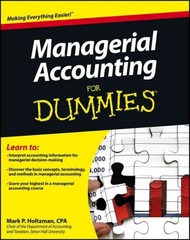Question
***Please see and use attached templates**** Thank you! 1. A partnership has the following capital balances: A ( 20% of profits and losses) $ 100,000
***Please see and use attached templates**** Thank you!
1. A partnership has the following capital balances:
A ( 20% of profits and losses) $ 100,000
B ( 30% of profits and losses) $ 120,000
C ( 50% of profits and losses) $ 180,000
If the partnership is to be liquidated and $ 30,000 becomes immediately available, who gets that money? Show your work:
Since the partnership currently has total capital of $400,000 the $30,000 that is available would indicate maximum potential losses of $370,000.
2. The following balance sheet is for a local partnership in which the partners have become very unhappy with each other.
To avoid more conflict, the partners have decided to cease operations and sell all assets. Using this information, answer the following questions. Each question should be viewed as an independent situation related to the partnerships liquidation.
a. The $ 10,000 cash that exceeds the partnership liabilities is to be disbursed immediately. If profits and losses are allocated to Adams, Baker, Carvil, and Dobbs on a 2: 3: 3: 2 basis, respectively, how will the $ 10,000 be divided?
b. The $ 10,000 cash that exceeds the partnership liabilities is to be disbursed immediately. If profits and losses are allocated on a 2: 2: 3: 3 basis, respectively, how will the $ 10,000 be divided?
Show your work.
 UNIT 7 POST PROBLEM 1 TEMPLATE Reported Balances Assumed $370,000 loss Potential balances Potential loss from C's deficit* Current cash distribution $ *The split is 20/30 or 40%/60% A, Capital 100,000 $ B, Capital 120,000 $ C, Capital 180,000 Extra Problem 2 Distribution of $10,000 excess cash Allocation of potential loss if the assets of 130,000 and 120,000 are worth zero. Distribute Baker deficit after extrapolating 20/20 to 50/50 for 100% Computation of $10,000 cash going to Dobbs 20% Adams 80,000 30% Baker 30,000 30% Carvil 60,000 20% Dobbs 90,000 80,000 30,000 60,000 -10,000 80,000 You need to do a worst case computation as follows 40,000 130,000 120,000 30,000 80,000 -50,000 30,000 -75,000 60,000 -75,000 90,000 -50,000 30,000 -30,000 -45,000 45,000 -15,000 15000 40,000 -30,000 0 0 0 10,000 Cash 40,000 Land Building Liabilities 130,000 120,000 30,000 -10,000 30,000 130,000 120,000 30,000 UNIT 7 POST PROBLEM 2 TEMPLATE Requirement A: Since the partnership currently has total capital of $260,000, the $10,000 that is would indicate maximum potential losses of $250,000. Adams, Capital Reported Balances Assumed $250,000 loss (2:3:3:2) Potential balances Potential loss from deficits (1:1) Current cash distribution Requirement B: Same cash to distribute, different allocations: Adams, Capital Reported Balances Assumed $250,000 loss (2:2:3:3) Potential balances, Step 1 Potential loss from deficits (4:6) Potential balances, Step 2 Potential loss from deficit (100%) Current cash distribution 0,000, the $10,000 that is available Baker, Capital Carvil, Capital Dobbs, Capital Baker, Capital Carvil, Capital Dobbs, Capital
UNIT 7 POST PROBLEM 1 TEMPLATE Reported Balances Assumed $370,000 loss Potential balances Potential loss from C's deficit* Current cash distribution $ *The split is 20/30 or 40%/60% A, Capital 100,000 $ B, Capital 120,000 $ C, Capital 180,000 Extra Problem 2 Distribution of $10,000 excess cash Allocation of potential loss if the assets of 130,000 and 120,000 are worth zero. Distribute Baker deficit after extrapolating 20/20 to 50/50 for 100% Computation of $10,000 cash going to Dobbs 20% Adams 80,000 30% Baker 30,000 30% Carvil 60,000 20% Dobbs 90,000 80,000 30,000 60,000 -10,000 80,000 You need to do a worst case computation as follows 40,000 130,000 120,000 30,000 80,000 -50,000 30,000 -75,000 60,000 -75,000 90,000 -50,000 30,000 -30,000 -45,000 45,000 -15,000 15000 40,000 -30,000 0 0 0 10,000 Cash 40,000 Land Building Liabilities 130,000 120,000 30,000 -10,000 30,000 130,000 120,000 30,000 UNIT 7 POST PROBLEM 2 TEMPLATE Requirement A: Since the partnership currently has total capital of $260,000, the $10,000 that is would indicate maximum potential losses of $250,000. Adams, Capital Reported Balances Assumed $250,000 loss (2:3:3:2) Potential balances Potential loss from deficits (1:1) Current cash distribution Requirement B: Same cash to distribute, different allocations: Adams, Capital Reported Balances Assumed $250,000 loss (2:2:3:3) Potential balances, Step 1 Potential loss from deficits (4:6) Potential balances, Step 2 Potential loss from deficit (100%) Current cash distribution 0,000, the $10,000 that is available Baker, Capital Carvil, Capital Dobbs, Capital Baker, Capital Carvil, Capital Dobbs, Capital Step by Step Solution
There are 3 Steps involved in it
Step: 1

Get Instant Access to Expert-Tailored Solutions
See step-by-step solutions with expert insights and AI powered tools for academic success
Step: 2

Step: 3

Ace Your Homework with AI
Get the answers you need in no time with our AI-driven, step-by-step assistance
Get Started


